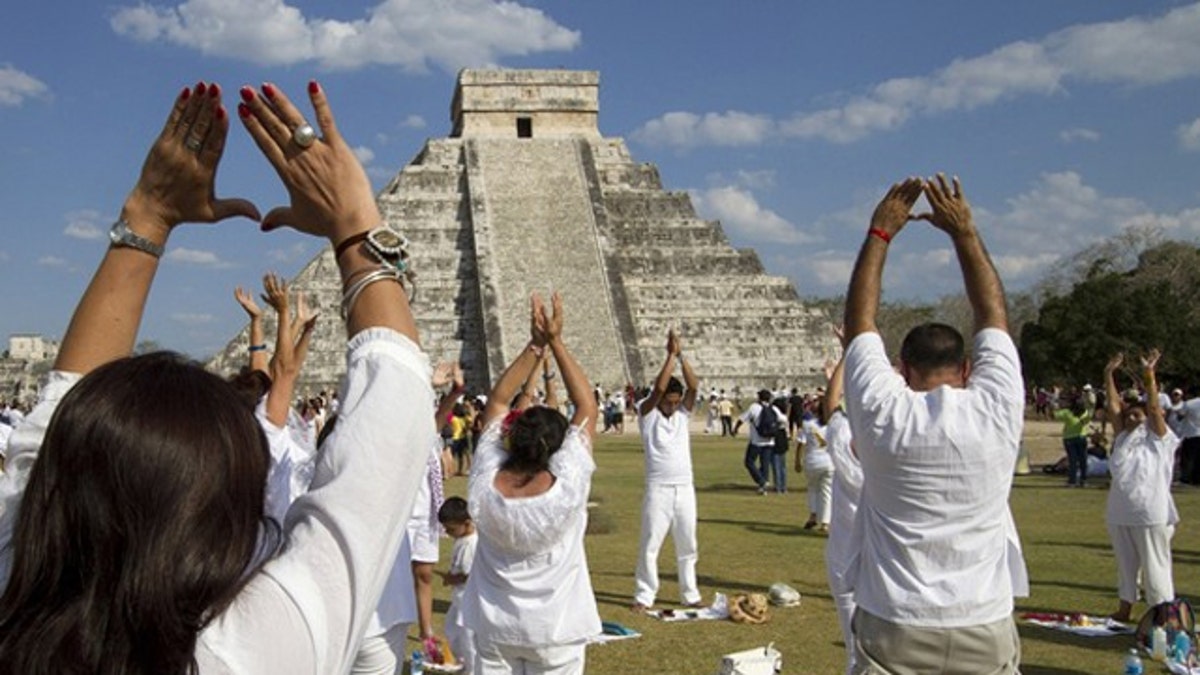
The world probably isn't ending, according to NASA. (Reuters)
Doomsday reports have reached a fever pitch this year -- and it's all thanks to the Mayans.
On Dec. 21, 2012, many doomsday believers fear the apocalypse will arrive -- anything from a rogue planet smashing into us to our world spinning end over end. That surge probably comes from the ancient Mayan calendar, and if you try to flip through one from December 2012 to 2013 you'll see exactly why.
According to the ancient Mayan "Long Count" calendar, next year's winter solstice marks the end of a 144,000-day cycle. This cycle, which begins at the mythical Maya creation date, has already been repeated 12 times. The 13th will end in 2012, capping a full 5,200-year Mayan cycle of creation.
Even NASA is trying to debunk the story.
"Just as the calendar you have on your kitchen wall does not cease to exist after December 31, the Mayan calendar does not cease to exist on December 21, 2012. This date is the end of the Mayan long-count period but then -- just as your calendar begins again on January 1 -- another long-count period begins for the Mayan calendar," the space agency recently wrote.
This date has long been shrouded in mystery, with many claiming that it will bring destruction to our planet -- so much so that the movement has turned into a cultural phenomenon. The Mexico tourism board has even stated its intentions to use the year 2012 as a springboard for its ailing tourism industry by leveraging the world's sudden interest in Mayan history.
But will the world actually end? Experts still say no.
Rogue planet Nibiru?
Anotther fear is that a rogue planet that has been dubbed "Nibiru" or "Planet X" is supposedly aimed at Earth. Self-proclaimed Nibiru expert Nancy Lieder, who says she is in contact with the aliens from Zeta Reticuli, first said Nibiru would cause widespread disaster in May 2003, only to change it to Dec. 21, 2012.
There is, however, no evidence that Nibiru is real.
"Nibiru is ridiculous because it doesn't exist — it never existed as anything other than a figment of the imagination by pseudo-scientists who don't seem bothered by a complete lack of evidence," astronomer Don Yeomans, manager of NASA's Near-Earth Object program office at the Jet Propulsion Laboratory in Pasadena, Calif., told SPACE.com.
There is no basis for the claim that it might be lurking behind the sun, as it could not have hidden from observation until now, Yeomans said. If such a planet was headed toward Earth by Dec. 21, 2012, it would already be visible to the naked eye.
Cosmic alignments?
There are also concerns that planets or stars might line up in ways that will transform Earth. For instance, some theorists claim that from our point of view, the sun will cross in front of the plane of our galaxy on Dec. 21. However, the sun already does this twice a year, Yeomans said.
In fact, the sun will eventually cross the plane of our galaxy. However, the sun is about 67 light-years from the galactic plane, so it should take several million years to do so, Yeomans said. Even then, when our solar system finally does cross the plane, nothing special will occur, he added. [10 Failed Doomsday Predictions]
Some also claim that gravitational effects from planets lining up with each other will somehow affect Earth. However, there is no planetary alignment due on Dec. 21, 2012, "and if there were, it wouldn't cause any problems," Yeomans said.
The only bodies that have any significant gravitational impact on Earth are the moon and the sun, effects we see as the tides. Tidal effects from other bodies in our solar system are negligible at best, and in any case, we have experienced them for millions of years without notice.
Flip-flopping Earth?
There is some alarm that 2012 could see the flipping of Earth's poles — either the planet's geographical poles, which mark the Earth's axis of rotation, or its magnetic poles, which our compasses point toward.
But, there is no reason to fear such an occurrence, scientists said, because the moon stabilizes our planet's spin. The planet's magnetic poles do flip, but over periods of about 500,000 years, and not suddenly, "but over thousands of years," with no evidence of a flip on Dec. 21, 2012, Yeomans said.
Even if the planet's magnetic poles do flip, no real problems would occur, other than the inconvenience of us having to change our compasses from north to south, he added.
Cosmic impacts?
The Earth is always vulnerable to impacts by comets and asteroids, but giant impacts are rare, with the last major collision taking place 65 million years ago, ending the Age of Dinosaurs.
Still, astronomers do monitor the sky for near-Earth objects.
"There are no known near-Earth objects in 2012 that present a credible risk to Earth," Yeomans said. "None, zero, zip, nada."
But despite evidence to the contrary, doomsdays theorists have garnered attention, and similar prophecies will continue to proliferate unless scientists become more involved in bringing truth to these outlandish claims, Yeomans said.
Mounting hysteria regarding these unfounded doomsday predictions "will improve only if scientists get more engaged in debunking pseudoscience," he said.




















